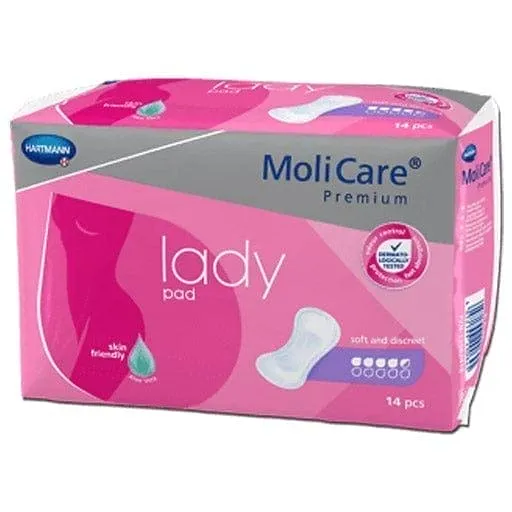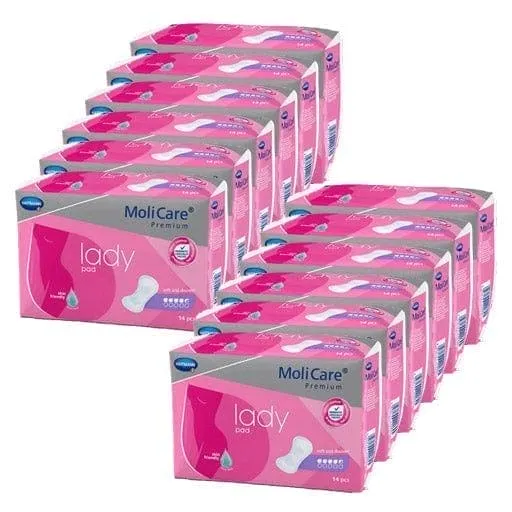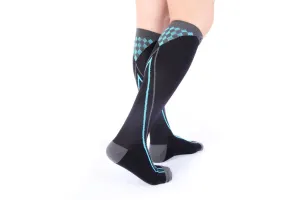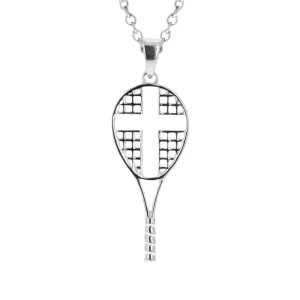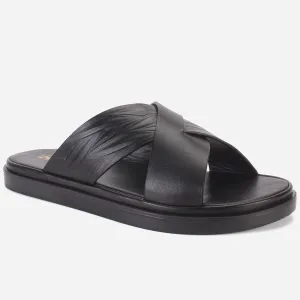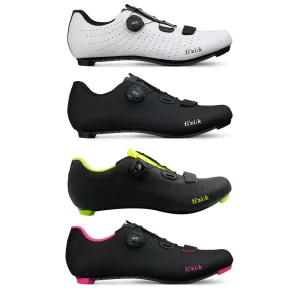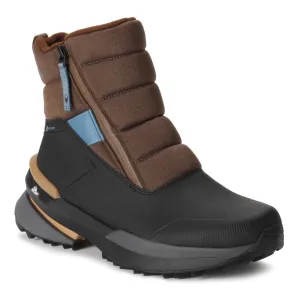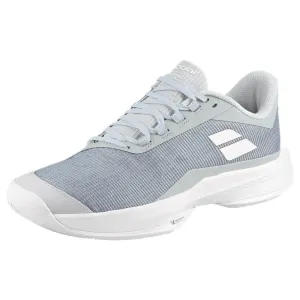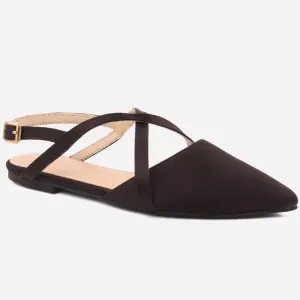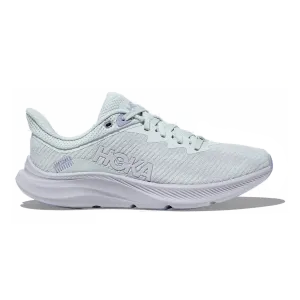MOLICARE Premium lady pad 4.5 drops
Individual needs - especially for you
Do what you feel like doing and what makes you happy - with the new MoliCare ® Premium lady products! If there are signs of bladder weakness, you should seek competent and sensitive advice at an early stage. With the right insoles or pants, you can feel comfortable in your skin again and enjoy your life in a self-determined manner and master challenges.
The new MoliCare ®Premium lady products were specially developed for the female anatomy and offer the security you want for bladder weakness. Fast absorbency, leak protection and the neutralization of possible odors provide optimal security and self-confidence with bladder weakness. A pH skin-neutral distribution pad helps to maintain the natural pH value of the skin and also has an antibacterial effect. The soft material and a cover treated with aloe vera ensure that it is comfortable to wear. The low waist of the pants, which does not alter the body silhouette, and the fit and wearing comfort like underwear round off the advantages of MoliCare ® lady pants. The lady pads were specially developed for discreet wearing in underwear.
Pants specially developed for women with moderate bladder weakness for all-round protection, discretion and excellent wearing comfort like underwear.
Stress incontinence – a typical female ailment
Many women are familiar with this: Small amounts of urine are released during physical exertion, coughing, sneezing or laughing. Commonly known as bladder weakness, doctors refer to this form of incontinence as stress incontinence or stress incontinence.
The reason why women are more likely to suffer from stress incontinence than men is due to the female anatomy: the rectum with the anus, the uterus with the vagina and the urinary bladder with the urethra are located close together in the so-called small pelvis. The lower part of the front wall of the uterus is attached to the back wall of the bladder. The pelvis is closed off by a muscle plate that has openings for the anus, vagina and urethra. It is called the pelvic floor - and it is precisely this pelvic floor that now plays a decisive role in the development of urinary incontinence.
When the pelvic floor no longer supports
In a healthy state, the pelvic floor is firm enough to support the abdominal organs and keep them in their anatomically correct position. If the musculature of the pelvic floor relaxes, it can no longer fulfill its supporting function. The abdominal organs step deeper. As a result of this change in position, the ability of the sphincter muscle system of the urethra to close is impaired and incontinence occurs. The form of incontinence that develops from a weakness of the pelvic floor is what doctors call stress incontinence. The involuntary loss of urine occurs during vigorous physical exercise or exertion (= stress), for example when coughing, jumping or laughing. The reason for this is as follows: These efforts increase the pressure in the abdomen. While a secure closure of the urethra is still guaranteed with an intact pelvic floor, this is no longer the case with a relaxed pelvic floor. The bladder neck opens. If the pressure inside the bladder then exceeds the reduced closure pressure, urine leaks involuntarily. At first only drop by drop, but with progressive loss of function also when walking and finally when lying down.
Why does the pelvic floor sag?
The greatest stress tests for the pelvic floor muscles are pregnancy and childbirth. The pelvic floor, like the abdominal wall, is subject to increasing pressure due to the enlarging uterus. During a vaginal birth, these forces on the pelvic floor increase significantly. This can damage the pelvic floor muscles.
Other possible causes of stress incontinence:
- constant heavy work that puts strain on the abdomen
- chronic constipation that causes you to push too hard
- hormone deficiency during menopause
- hereditary connective tissue weakness
- severe overweight
- general muscle wasting with age
What can be done about stress incontinence?
Treatment of stress incontinence aims to keep the bladder and urethra with the sphincter system in a stable, "closable" position in situations of sudden physical stress. Depending on the severity of the incontinence, there are different treatment options. Special pelvic floor training is recommended for mild incontinence. Estrogen deficiency is common in women going through the menopause. Doctors recommend hormone therapy to compensate for the deficiency. In severe cases of incontinence, surgery may also be considered.
Tips for self-help
What can you do to prevent incontinence or to support the healing process?
- Pelvic floor exercises can easily be done at home. Learn more about it here.
- If you are overweight, it is advisable to lose weight. Nutritional counseling or group discussions can be helpful here. You can find out more about the connection between incontinence and obesity here.
- In the case of chronic constipation, a doctor should take stool-regulating measures, as they can relieve the pelvic floor.
Promising: pelvic floor training for incontinence
Regular training to strengthen the muscles of the pelvic floor is a promising treatment for mild to moderate stress incontinence.
Like arm, leg or abdominal muscles, the muscles of the pelvic floor can also be strengthened with special exercises. They consist of so-called skeletal muscles that can be trained.
Important prerequisites
Certain prerequisites must be observed when training the pelvic floor. The patients must be motivated to keep up intensive pelvic floor exercises over a longer period of time. Because after the first successes, those affected must continue to train in order to keep the muscles moving. A muscle that is not working and moving would relax again.
There must be no medical problems such as a prolapsed uterus in women. In the case of mixed stress/urge incontinence, drug therapy for urge incontinence is recommended at the same time.
Men can often completely eliminate the leakage of urine after prostate surgery through consistent pelvic floor training.
Advice and help for people with incontinence
Professional societies, self-help organizations and also commercial companies want to make an active contribution to improving the living conditions of incontinent people.
The offer is varied and can also be used anonymously. With around nine million people affected, incontinence is one of the most common diseases of old age in our society. This is not least due to the demographic change towards an aging society - a development that the healthcare system has long been unable to ignore. Professional societies, specialized clinics and self-help associations now offer a wide range of help. However, health insurance companies and companies that are active in this area, such as HARTMANN, also offer helpful information and can serve as contacts. Those affected and their caring relatives can contact the various facilities directly via the Internet or by telephone with their questions and problems.
Some important contact points for advice and help with incontinence are presented here:
Deutsche Kontinenz Gesellschaft eV
The Deutsche Kontinenz Gesellschaft e. V. has been working since 1987 to get the "embarrassing" disease of incontinence out of the taboo zone. In doing so, she wants to take the suffering of those affected and pave the way for improved diagnosis and treatment.
On her website she provides information about the various forms and diseases of incontinence. It offers addresses of medical advice centers, rehabilitation clinics, continence and pelvic floor centers and continence self-help groups throughout

 Cart(
Cart(